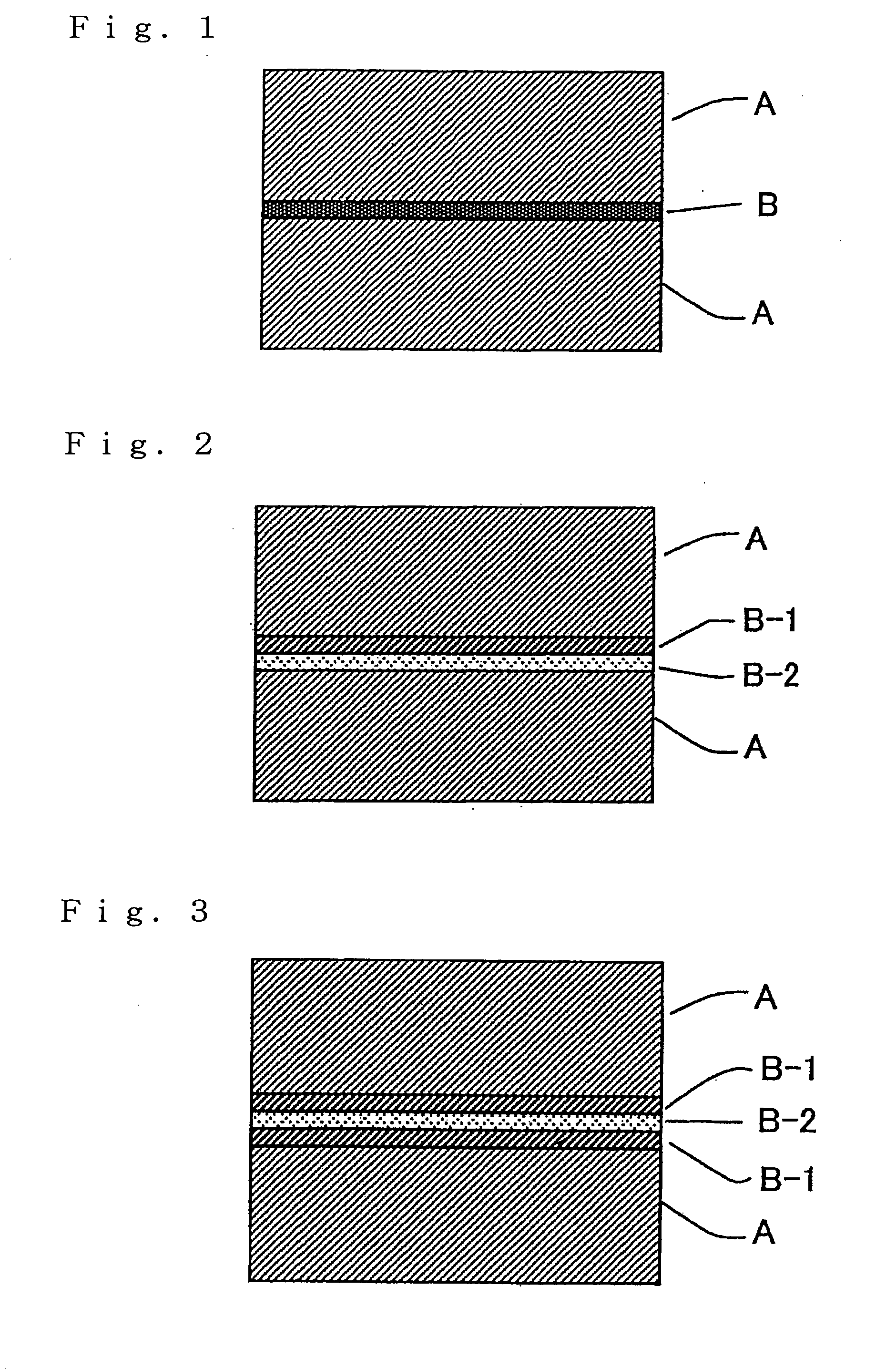Paper for card, method for producing same and playing cards
a technology of playing cards and paper, applied in the field of paper for cards, can solve the problems of user fingerprints, plasticizer may bleed out on the surface of playing cards during use, and may not be so tough,
- Summary
- Abstract
- Description
- Claims
- Application Information
AI Technical Summary
Benefits of technology
Problems solved by technology
Method used
Image
Examples
production example 1
[0070] The thermoplastic resin composition (a) was kneaded in an extruder set at 230° C., and then fed to an extrusion die set at 250° C. and sheetwise extruded out through it. This was then cooled in a cooling device to obtain an unstretched sheet. The unstretched sheet was heated at 145° C. and then stretched 3.5-fold in the machine direction. After the thermoplastic resin composition (c) was kneaded in an extruder set at 250° C., this was sheetwise extruded out and laminated on both the surface and the back of the 3.5-fold stretched film that had been prepared in the above, to thereby obtain a three-layered laminate film. Next, the three-layered laminate film was cooled to 60° C. and then again heated at about 155° C. in a tenter oven in which this was stretched 8.0-fold in the lateral direction. Then, this was subjected to heat treatment in a heat set zone controlled at 160° C. Next, this was cooled to 60° C., and its edges were trimmed away. Its surface and back were subjected ...
production example 2
[0071] The thermoplastic resin composition (b) was kneaded in an extruder set at 230° C., and then fed to an extrusion die set at 250° C. and sheetwise extruded out through it. This was then cooled in a cooling device to obtain an unstretched sheet. The unstretched sheet was heated at 145° C. and then stretched 3.5-fold in the machine direction. After the thermoplastic resin composition (c) was kneaded in an extruder set at 250° C., this was sheetwise extruded out and laminated on both the surface and the back of the 3.5-fold stretched film that had been prepared in the above, to thereby obtain a three-layered laminate film. Next, the three-layered laminate film was cooled to 60° C. and then again heated at about 155° C. in a tenter oven in which this was stretched 8.0-fold in the lateral direction. Then, this was subjected to heat treatment in a heat set zone controlled at 160° C. Next, this was cooled to 60° C., and its edges were trimmed away. Its surface and back were subjected ...
production example 3
[0072] The thermoplastic resin composition (a) was kneaded in an extruder set at 230° C., and then fed to an extrusion die set at 250° C. and sheetwise extruded out through it. This was then cooled in a cooling device to obtain an unstretched sheet. The unstretched sheet was heated at 140° C., then stretched 4.5-fold in the machine direction, and thereafter further heated at 155° C. by the use of a heat-setting roll system with plural rolls. Then, this was cooled to 60° C., and its edges were trimmed away. Its surface and back were subjected to corona discharge treatment at 40 W / m2. Thus, a single-layered monoaxially-stretched white film having a thickness of 170 μm was obtained.
PUM
| Property | Measurement | Unit |
|---|---|---|
| porosity | aaaaa | aaaaa |
| thickness | aaaaa | aaaaa |
| flexural modulus | aaaaa | aaaaa |
Abstract
Description
Claims
Application Information
 Login to View More
Login to View More - R&D
- Intellectual Property
- Life Sciences
- Materials
- Tech Scout
- Unparalleled Data Quality
- Higher Quality Content
- 60% Fewer Hallucinations
Browse by: Latest US Patents, China's latest patents, Technical Efficacy Thesaurus, Application Domain, Technology Topic, Popular Technical Reports.
© 2025 PatSnap. All rights reserved.Legal|Privacy policy|Modern Slavery Act Transparency Statement|Sitemap|About US| Contact US: help@patsnap.com


